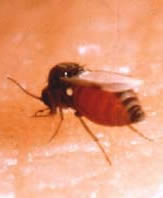 Coping with No-See-Ums - July 27, 2016 Jeff Schalau, Agent, Agriculture & Natural Resources University of Arizona Cooperative Extension, Yavapai County No-see-ums are small biting flies that appear during the summer months. These tiny biting insects are barely visible to the naked eye, but their bites can be very painful and annoying. Also known as biting midges or punkies, these minute insects are probably familiar to outdoor enthusiasts, gardeners, farmers, and ranchers. Each year, I get several calls from residents that think they have flea bites or chiggers, but after speaking to them, we usually find they have been bitten by no-see-ums. Literature references indicate that no-see-um species found in Arizona and the southwest are of the genus Culicoides (family Ceratopogonidae). Adult no-see-ums are less than 1/16-inch long, can easily pass through normal window screens, and resemble a smaller, more compact version of the mosquito. They are most active in early mornings and evenings of mid to late summer. Mouth parts are well developed with elongated mandibles adapted for blood sucking. Both males and females feed on flower nectar but only the female feeds on blood. She must consume blood for her eggs to mature and become viable. No-see-um eggs are laid on moist soil. Common breeding areas include the edges of springs, streams and ponds, muddy and swampy areas, tree holes, and even water associated with air conditioning units. University of Arizona Entomologist, Carl Olson, says they also breed in moist disturbed soil such as that found around construction sites or freshly plowed ground. The eggs hatch in as little as 3 days. The wormlike larvae have short brush like breathing structures that allows them to breathe in an aquatic environment. Although larvae are not strictly aquatic or terrestrial, they cannot develop without moisture. After feeding on decomposing organic matter and pupating, adults emerge, feed, and mate. As mentioned previously, bites of these tiny flies are painful and irritating. The bite usually starts as a small red welt (1/8” or so) or water-filled blister that itches. Once scratched, the welt can break open and bleed, but the itching usually continues. Allergic or sensitive individuals may develop long-lasting painful and itchy lesions. Bite treatments recommended by some dermatologists include topical cortisone creams and non-steroidal anti-inflammatory drugs such as aspirin or ibuprofen. Persons having severe reactions should consult a physician or dermatologist. Insect repellents containing DEET typically used against mosquitoes are also labeled for use against biting midges. Always follow the label precautions and apply before exposure to the insects. Botanical insect repellents (those containing citronella, eucalyptus, and other plant extracts) may also provide some protection. Occasionally no-see-ums and biting midges will enter houses and screened patios through standard 16 mesh screening and netting or damaged areas of the screen. If this is the case you can replace damaged screen with tighter mesh screen, treat existing screen with an approved insecticide such permethrin, or use fans to keep them from flying in your general vicinity. The best strategy to prevent no-see-um bites is to wear long sleeve shirts, long pants, shoes and socks, and a hat during times when no-see-ums are most active. Choose lighter colored garments and consider hats with fine meshed netting. No-see-um-proof netting is also available and outdoor equipment companies market head nets, jackets, and pants made from this material. These products may come in handy depending on your preferences and outdoor activity preferences. While I don’t own one, the head net seems like an excellent idea. Of course, these same strategies are also effective against mosquitoes and black flies. No-see-ums are primarily a nuisance. The major medical issue associated with them is allergic reactions to the bites. However, like other blood feeding flies, some Culicoides species carry pathogens that can cause disease in humans and animals. One species (Culicoides sonorensis) is known to transmit the bluetongue virus, a serious disease of sheep and cattle. The online edition has photos and additional information (see URL below). Follow the Backyard Gardener on Twitter – use the link on the BYG website. If you have other gardening questions, call the Master Gardener help line in the Camp Verde office at 928-554-8992 or e-mail us at verdevalleymg@gmail.com and be sure to include your name, address and phone number. Find past Backyard Gardener columns or provide feedback at the Backyard Gardener web site: http://cals.arizona.edu/yavapai/anr/hort/byg/. Additional Resources You don’t See ’em, but you Sure Feel ‘em! UF/IFAS Extension okeechobee.ifas.ufl.edu/News%20columns/No.See.Ums.htm Photo of No-See-Um (Chris Wirth, BugGuide) bugguide.net/node/view/30987/bgimage A sixteenth-inch-long female biting midge, Culicoides sonorensis, feeds blood delivered through artificial membrane developed for mass insect rearing. (Scott Bauer, USDA/ARS) www.ars.usda.gov/is/graphics/photos/jul99/k8488-1.htm |